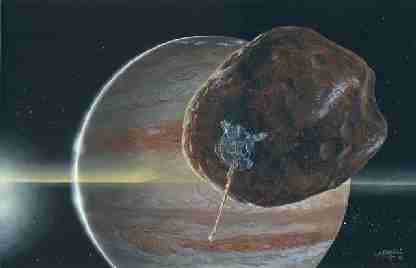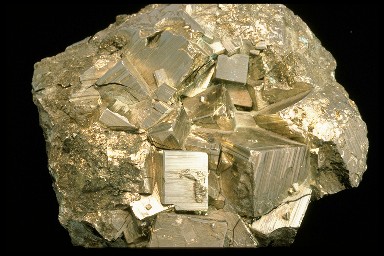This image shows a pool ball floating on liquid mercury. A pool ball is fairly heavy for its size, but you can see it floats on, or is less dense, than liquid mercury.
Click on image for full size
Density Definition Page
Density is a measure of how much mass is contained in a given unit volume (density = mass/volume). It is usually expressed in kg/m^3. Put simply, if
mass is a measure of how much ‘stuff’ there is in an object, density is a measure of how tightly that ‘stuff’ is packed together.
One of the ways we can see density illustrated in everyday life is by looking at whether things float or sink in a liquid (water, for example). If an object is less dense than the liquid it is placed in, it will float. If it is more dense, it will sink. This is why an anchor, which is very dense (lots of mass in a relatively small volume) sinks very quickly, while an inner tube (not much mass in a relatively large volume) floats and is very difficult to push underwater.
Some elements are naturally found in very dense forms, and one of the most surprising cases of a less dense object floating on a denser liquid occurs when objects are put in a container of liquid mercury (Hg). This element is a metal that is liquid at room temperature, and it is VERY dense. In fact, it is denser than lead, and metal objects like forks, coins, or even a cannonball will float on top of it!
You might also be interested in:

Would it be more difficult to pull an elephant or a mouse? If you pulled each animal with the same amount of force, the elephant would respond less to pulling, even if he didn’t pull back at all. That’s
...more
Amalthea, a small reddish moon of Jupiter, is not made of Swiss cheese, but it does seem to be full of holes making its density surprisingly low according to new information from the Galileo spacecraft.
...more
The periodic table on the left separates elements into three groups: the metals (green in the table), nonmetals (orange), and metalloids (blue). Most elements are metals. They are usually shiny, very
...more
Solid is one of the four common states of matter. The three others are gas, liquid, and plasma. There are also some other exotic states of matter that have been discovered in recent years. Unlike liquids
...more
Seawater moves through the Atlantic as part of the Global Ocean Conveyor, the regular pattern by which seawater travels the world’s oceans. The water in the Global Ocean Conveyor circulates because of
...more
AU stands for Astronomical Units. It is a useful way to measure the distances in interplanetary space. It is the distance between the Earth and the Sun, which is about 93 million miles. For reference,
...more
The solar wind is formed as the Sun's top layer blows off into space, carrying magnetic fields still attached to the Sun. Gusts form in the solar wind associated with violent events on the Sun. Particles
...more















